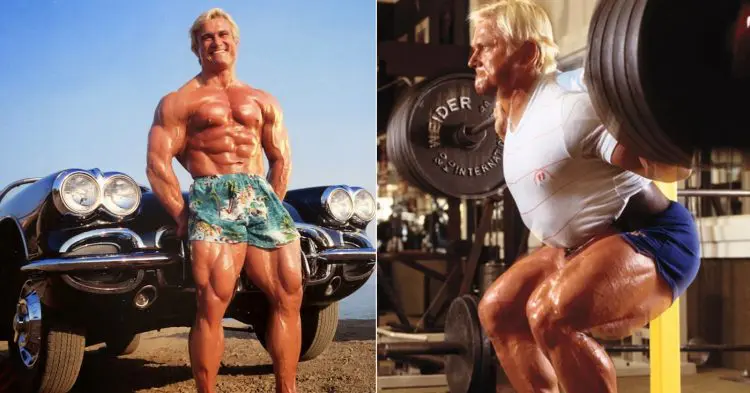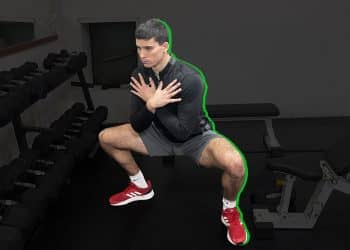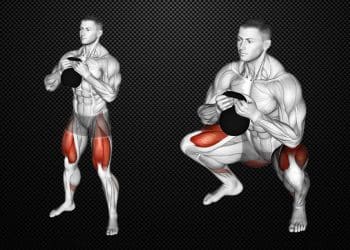Most exercisers have a love-hate relationship with squats. We love how they’re so effective for building muscle mass and strength but hate how tough they are. To make matters worse, a hard squat workout can have a lasting effect, leaving you tired and sore for days; it’s like having a squat hangover!
While some exercisers have managed to build impressive lower bodies without paying their dues in the squat rack, they are relatively few and far between. In fact, squats are probably responsible for building more muscle mass than any other exercise.
That said, there are several different types of squats to choose from, including goblet squats, Zercher squats, box squats, Anderson squats, and overhead squats, so which one should you choose?
In this article, we compare sumo and regular squats so you can pick the right variation for your workout needs and goals.
Sumo Squat
Sumo squats, also known as wide stance squats, are often done by general exercisers to increase inner and outer thigh engagement. They can be done using a barbell or a single dumbbell or kettlebell, i.e., “goblet squat style.”
Like all types of squats, sumo squats involve your glutes, hamstrings, and quadriceps. But, using a wider stance also increases inner and outer thigh muscle activation. Powerlifters also use sumo squats to reduce the distance they have to move and lift more weight.
Level Up Your Fitness: Join our 💪 strong community in Fitness Volt Newsletter. Get daily inspiration, expert-backed workouts, nutrition tips, the latest in strength sports, and the support you need to reach your goals. Subscribe for free!
Sumo squats require and develop hip flexibility and mobility. This can be a distinct disadvantage for some exercisers as tight hips will make this exercise much harder to do correctly.
Muscles Worked
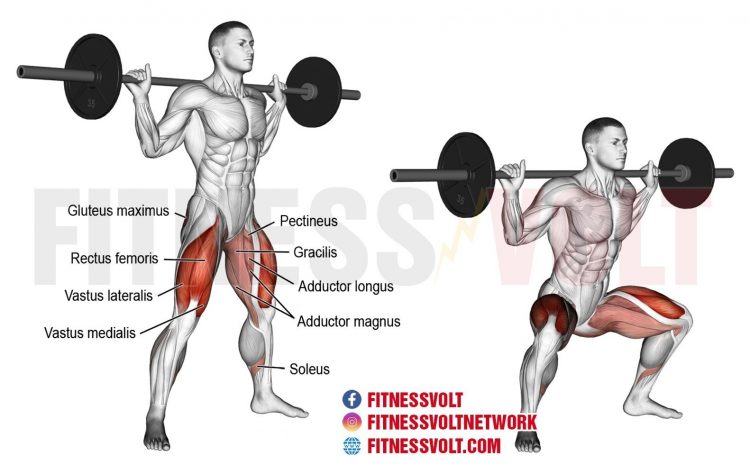
Sumo squats are a compound lower body exercise that works several joints and muscles at the same time. The primary muscles involved in sumo squats are:
- Quadriceps – front of the thigh
- Hamstrings – back of the thigh
- Gluteus maximus – back of hip
- Abductors and adductors – outer and inner thighs
- Erector spinae – lower back
- Core – midsection/abs
- Trapezius – mid and upper back
- Rhomboids – mid back
The wide stance means the glutes, abductors, and adductors are engaged more than they would be with a narrower stance.
How to do sumo squats
- Place a barbell in a squat rack so the bar is about shoulder-level. Grab the bar with a slightly wider than shoulder-width grip and duck under it. Press your upper back against the bar, so it sits on your traps and NOT your neck. Brace your abs and pull your shoulders down and back.
- Lift the bar off the supports and take 1-2 steps back. Move your feet out so that they are wider than shoulder-width apart. Turn your feet out slightly, so your toes and knees are pointing the same way.
- Pushing your feet and knees outward, push your hips back and squat down until your thighs are roughly parallel to the floor. Do not round your lower back. Keep your upper body tight and look straight ahead.
- Without bouncing, drive your feet into the floor and stand up straight. Keep pushing your knees outward. Reset your core and repeat.
- You’ll need to experiment to find the ideal foot placement for sumo squats. Start off with your feet slightly outside shoulder width and adjust from there. Move your feet in or out until you find the most comfortable, powerful position.
Sumo Squat – Pros
Not sure if sumo squats deserve a place in your workouts? Consider these benefits:
More balanced leg development – wide stance squats increase inner and outer thigh engagement and also give your glutes a good workout (1). As a result, they deliver a more rounded leg workout than some other types of squats. Narrow stance squats are usually more quadriceps-centric, and the inner and outer thighs are much less involved.
Less low back stress – squatting with a wide stance makes it easier to maintain a more upright torso. In contrast, regular squats tend to involve more forward lean, putting more pressure on your lower back. Sumo squats can help take stress off the lumbar spine.
Increased hip mobility and flexibility – if you want more mobile hips but don’t want to resort to more traditional stretching methods, sumo squats could help. Using a wider stance stretches your hips and could increase your flexibility, mobility, and functional range of motion. After a few weeks of sumo squats, you may even find that your regular squat depth increases.
Better joint stability – doing sumo stance squats means pushing your knees outward, which increases hip stabilizer activity. Increased hip joint stability could prevent hip AND knee injuries, as well as improve your athletic performance. If your knees tend to cave in during exercises like leg presses and lunges, doing more sumo squats could help.
Less knee stress – squatting with a wider stance means you should be able to keep your shins more vertical. This will reduce knee stress. In contrast, regular squats often involve forward knee travel, putting more pressure on the knee joints. Wide stance squats are a helpful exercise for lifters with knee pain and may offer a more comfortable workout.
It is easier to keep your heels down – tight calves and immobile ankles can make it hard to keep your heels down during squats. Lifting your heels shifts your weight forward, which puts more stress on your knees and lower back. Sumo squats take tension off your calves and, with less forward knee travel anyway, it should be easier to keep your heels pressed into the floor.
Good transference to sumo deadlifts – if you want to increase your sumo deadlift performance, sumo squats could help. The movements are almost identical, and the only real difference is the position of the weight.
Sumo Squat – Cons
While sumo squats are most definitely a beneficial exercise, they’re not without drawbacks. Consider the following before adding sumo squats to your workouts:
Tight hips will limit squat depth – most people should squat down until their thighs are parallel to the floor. You even want to go deeper, i.e., “ass to grass.” But, if you’ve got tight hips, you probably won’t be able to sumo squat as deeply as you can with a more conventional stance.
Related: How Deep Should You Squat?
Hip pain – sumo squats can cause hip pain, especially if you are unused to doing this wide stance variation. Avoid any hip-related problems by increasing the width of your stance gradually. Move your feet further apart as you get used to this exercise.
May feel unnatural – if you usually do conventional stance squats, switching to sumo squats will feel unusual. They could even be uncomfortable and put you off doing squats with your feet so far apart. However, with time and practice, they’ll soon begin to feel more natural.
Regular Squat
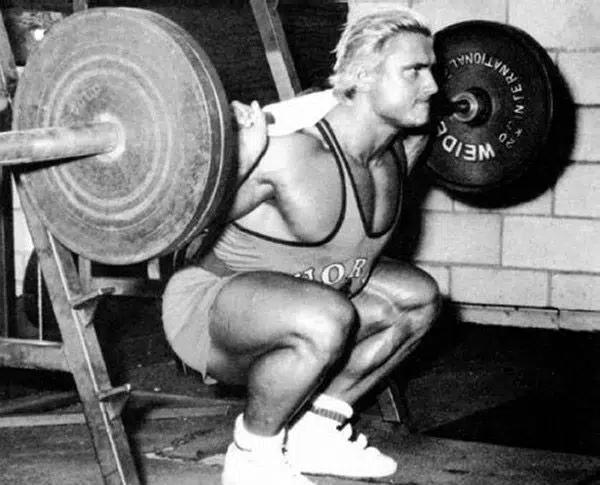
Regular or conventional squats are a very popular lower body exercise. They’re usually done with a barbell resting across your upper back and known as back squats as a result. The bar can be held high across the traps or lower at shoulder level or below – the so-called high bar squat and low-bar squat, respectively. There are other types of bars that can be used for regular squats, including safety bars, curved bars, and cambered bars. Each one changes the way the load affects your body, but the actual movement remains mainly unchanged.
Read more about the difference between high bar and low bar squats here.
Bodybuilders tend to do regular squats to build bigger, more muscular quadriceps, as the conventional stance helps to target these muscles. However, regular stance squats are also popular with powerlifters, who use them in training and competition.
Muscles Worked
Regular squats use the same muscles as sumo squats, i.e.:
- Quadriceps – front of the thigh
- Hamstrings – back of the thigh
- Gluteus maximus – back of hip
- Abductors and adductors – outer and inner thighs
- Erector spinae – lower back
- Core – midsection/abs
- Trapezius – mid and upper back
- Rhomboids – mid back
However, because your stance is somewhere between shoulder and hip-width apart instead of wider, regular squats tend to involve more quadriceps activation than sumo squats and don’t use the abductors and adductors as much (1).
How to do regular squats
- Put a barbell in your squat rack at about shoulder height, so you don’t have to stand on tiptoes to unrack it.
- Duck under the bar so it rests on your traps or across your shoulders. Grip the bar with your hands just wider than shoulder-width apart. Pull your shoulders down and back and brace your core.
- Unrack the bar and take 1-2 steps back. Set your feet between hip and shoulder-width apart. The taller you are, the wider your stance will probably be. Turn your toes out slightly if you wish.
- Brace again, inhale, push your hips back, and bend your knees. Descend as far as you can without rounding your lower back.
- Ideally, your hips should be level with your knees and your thighs parallel to the floor at the midpoint of each rep. i.e., a parallel squat.
- Keep your knees in line with and behind your toes, and do not allow them to drop out or fall in. Look straight ahead and not down.
- Without bouncing out of the bottom, drive your feet into the floor and stand back up.
- Rerack the bar and rest or, if you are doing multiple reps, reset your core and repeat.
Regular Squat – Pros
More natural movement – compared to sumo squats, regular squats look and feel more natural. As such, they’re usually easier to learn and are the variation most exercisers tend to favor. Sumo squats are a more specialized movement.
Build bigger quadriceps – if you want to beef up your quads, regular squats are arguably better than sumo squats. With sumo squats, your quads ARE working, but some of the work falls on your abductors and adductors. The outer and inner thighs are less involved with narrower stance squats, and your quads have to work harder.
Level Up Your Fitness: Join our 💪 strong community in Fitness Volt Newsletter. Get daily inspiration, expert-backed workouts, nutrition tips, the latest in strength sports, and the support you need to reach your goals. Subscribe for free!
Get stronger – as well as being good for building muscle, regular squats are a very effective strength builder. While some powerlifters use sumo squats to lift massive weights, many more favor the conventional stance. You also tend to see more strongman competitors doing regular squats. As such, it’s a safe assumption that regular squats are an excellent exercise for building strength.
It’s easier to squat deep – most people can squat deeper with regular squats compared to sumo squats. Squatting deeper may produce better hypertrophy by increasing muscle activation. However, a deeper squat is not always a better squat, especially if you have knee issues.
Regular Squat – Cons
Like sumo squats, there are disadvantages to regular squats to consider:
Increased lower back stress – regular stance squats often involve a pronounced forward lean. Leaning forward puts more pressure on the lumbar spine, intervertebral discs, and ligaments. This issue is made worse if you push your hips too far to the rear. Sitting back too far usually leads to more forward lean and more back stress.
Less inner and outer thigh engagement – in regular squats, the adductors and adductors mainly act as stabilizers. In contrast, in sumo squats, they work harder and play a far greater role. If you want to target your inner and outer thighs, sumo squats are a better choice. But, for hitting your quads, a narrower stance is best.
Sumo Squat vs. Regular Squat
So, now that you know a little more about sumo and regular squats, let’s judge these exercises by a few different criteria:
Strength
All types of squats are useful strength builders, and that includes sumo and regular squats. Done with heavy weights and for low reps, both of these exercises will make you stronger. Which one is best? That probably depends on you.
If you have good hip mobility and prefer a more upright stance, sumo squats may be the one for you. But, if you naturally prefer a narrower stance and have strong quads, regular squats are probably better.
To determine which one is really best, try them both and see how you progress.
Hypertrophy
Regular and sumo squats are both effective muscle-building exercises. But, because they involve slightly different movements, they affect different muscles. Regular squats are more knee-dominant, so they emphasize your quads more. Sumo squats are more hip-dominant, so they work your glutes, hamstrings, abductors, and adductors a little more. Choose the variation that targets the muscles you wish to develop.
Safety
In terms of safety, both of these exercises are very similar. After all, they use the same equipment, and the movements are not all that different.
That said, sumo squats allow you to keep your torso more upright than back squats, which could make them safer for some people. However, if you’ve got tight hips, sumo squats could increase your risk of hip injury.
The chances of injury are very similar for both types of squats and can be minimized by choosing the variation that suits you best, using good technique, and increasing your weights gradually. Plus, using a squat rack will make both exercisers much safer.
Ease of learning
Regular squats tend to feel more natural than wide-stance squats. Most people are more comfortable adopting a shoulder to hip-width stance. Also, a conventional stance requires less mobility and flexibility.
In contrast, sumo squats feel less natural, and you’ll need above-average mobility and flexibility to do them correctly.
As a result, most people will find regular squats easier to learn than sumo squats.
Equipment
There is no difference between sumo and regular squats regarding equipment. Both exercises can be done using a barbell and squat rack or as a bodyweight exercise. If preferred, you can also do sumo and regular stance squats using a kettlebell or single dumbbell, i.e., goblet style. Equipment availability should not affect which of these two exercises you choose to do.
Long-term progression
There is no reason to think that your progress will stall if you choose sumo squats, or regular squats. Both exercises should allow you to keep adding weight or doing more reps for many years to come.
Variety
One of the best ways to avoid progress plateaus is to change your workout from time to time and use variations of your main exercises. In many cases, simply altering the width of your stance or the angle of your bench is all that’s needed to avoid training ruts.
There are lots of variations you can use for both sumo and regular squats, including:
- Box squats – briefly touch a box with your butt at the bottom of each rep
- Paused squats – pause at the bottom of each rep for 2-5 seconds
- Squats with chains or bands – to increase load as you approach lockout
- Speed squats – use 50% of your 1RM and lift the bar as fast as you can
- Anderson squats – start each rep with the bar resting on low pins in a power rack
As such, there is no reason to get bored or stuck in a training rut with sumo squats or front squats; there are plenty of variations that you can use with both these great exercises.
Wrapping Up
Squats are an incredibly versatile exercise you can use to achieve almost any training goal. It doesn’t matter if you want to build muscle mass, get stronger, improve your sports performance, or even burn fat and get lean; squats can help.
That said, there are several squatting variations to choose from. Each one has different benefits and advantages, so it pays to pick the right one for your training goal.
Sumo squats are helpful for targeting your inner and outer thighs and glutes. Still, you’ll need good mobility and flexibility to do them. Regular squats are more quads-centric, often feel more natural, and are easier to learn. However, they also tend to put more stress on your lower back.
So, which one is better? The answer depends on you!
For some, sumo squats are the way to go, but for others, regular squats will be the best choice. Use the exercise that matches your workout requirements or, if you cannot decide, why not do them both? After all, regular and sumo squats are two highly effective yet different exercises. That way, you can enjoy the benefits of these two excellent exercises.
References:
1 – PubMed: Stance Width and Bar Load Effects on Leg Muscle Activity During the Parallel Squat https://pubmed.ncbi.nlm.nih.gov/10188748/
Interested in measuring your progress? Check out our strength standards for Overhead Squat, Zercher Squat, Box Squat, and more.

